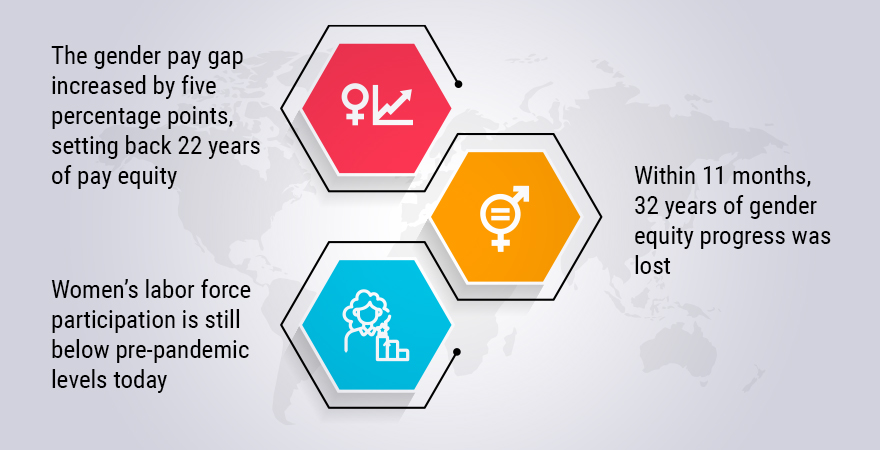Pandemic revelations across various facets of human life seem focused on a particularly hot topic today; the Great Resignation. Gaining more momentum within this issue is the declining participation of the female workforce; the Women’s Great Resignation or a more modishly known portmanteau, the Shecession. The main focus of organizations today however, is to get women who have left the workforce to return.

How much of the workforce is female?
The disproportionate employment between men in women in certain industries caused the loss of a large part of the workforce to be predominantly female. The same was identified by C. Nicole Mason, President and Chief Executive of the Institute for Women’s Policy Research, and the woman who coined the term she-cession, in reference to the 2008 mancession.
Women accounted for 55% of the 20.5 million jobs lost (NY Times), with higher unemployment rates for women of color (Black women 16.4%, Hispanic – 20.2 %). This brings into question an even bigger gap in diversity and inclusion moving forward.
As highlighted in a recent BLS report; The Labor Force Participation Rate for women was 57% in January 2022; the lowest recorded since 1988 – NWLC. Even with the recent job gains for women in January 2022; the recovery of all female jobs lost since February 2020 would require a growth rate ten times that of the January numbers – SHRM
Why did so many women leave the workforce?
Caregiving and childcare responsibilities have primarily fallen to women since the dawn of time. Many had to consider leaving work altogether to be the backup parent when it became impossible to juggle closure of schools, daycare duties, work, and managing housework on top of everything else. Stress and exhaustion are one of the main contributors that women had to consider when exiting the workforce. More troublesome was the plight of single mothers, whose unemployment rates tripled compared to men.
One in three women has considered leaving behind their careers in the past year alone – McKinsey Survey.
The hardest-hit industries have the highest number of female employees; leisure, hospitality, healthcare, education, etc. This crisis has set women back a decade from the jobs and roles they had gained over time – NY Times. As per a Linked In pulse article:
The gender pay gap increased by five percentage points, setting back 22 years of pay equity
Within 11 months, 32 years of gender equity progress was lost
Women’s labor force participation is still below pre-pandemic levels today
Accelerated more so by burnout due to added burden during the COVID-19 pandemic; women are leaving the workforce in droves. Women were impacted more as compared to men in this labor crisis, where some reasons to quit include gender discrimination at work, pay inequality, not enough growth opportunities, etc. among others

Supporting women returning to work
Women who have left the workforce are no longer looking for jobs – CNBC. According to an HBR study, women don’t apply for a job unless they feel they are 100% qualified for it. The longer women stay out of work, the harder it will get for them to return (Guardian); therefore, measures must be taken to mitigate long-term gender inequality effects on the workforce; already present and accelerated by the pandemic.
In 2020, women earned 82% of what men earned for similar positions, requiring an extra 42 days of work to fill the wage gap. To re-vitalize the women workforce, incentives have to be given to attract talent, while providing WFH, better bonuses, healthcare, and childcare packages.
The labor crisis is here to stay well till the third quarter of the year (Glassdoor), with many women missing from workforce as well. A current 15-year high talent shortage (ManpowerGroup Survey) requires the recruitment issue to be addressed by expanding to a global talent pool. Diversity and flexibility at work are innate to a Co-sourcing model, which also offers talent from various geographies.
Premier BPO envisions a healthy work environment, where women in the workforce are equally represented as men. A seasoned partner like Premier BPO can get a team of highly skilled and trained professionals suited to your business niche. We provide customized consultancy to every client, right-shoring their program to the optimum location. Our Culture and values are based on diversity, empathy, quality, and teamwork. Learn more about our work ethic at our about us page.
 Skip to content
Skip to content





